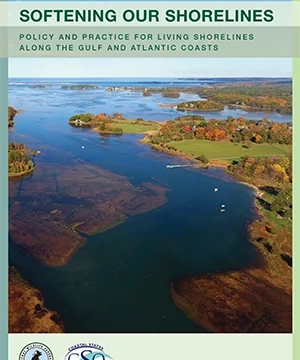Abstract or Summary

Over the past two decades the use of living shorelines to address coastal erosion has increased dramatically as landowners seek more natural solutions to shoreline stabilization. Approaches for protecting coastal properties from erosion and coastal storms traditionally have focused on erecting hard structures, but hardened shorelines can complicate coastal adaptation needs, and may be counterproductive in the face of inevitable inland shifts. In contrast, the softening of our shorelines where appropriate can enhance the capacity of coastal habitats and communities to adapt and respond to climate-driven changes. Although there has been progress in the adoption of these softer approaches in some states, the rate of living shoreline installation is still low relative to the amount of hardened shoreline protections.
To better understand the possible reasons for this discrepancy, the National Wildlife Federation worked in collaboration with the Coastal States Organization to assess the regulatory landscape relevant to the living shorelines permitting in all Atlantic and Gulf coastal states. Through research and a series of interviews with state agency personnel and other experts, we found that the permitting process for living shorelines varies considerably across states, and appears to play a significant, though not complete, role in either constraining or facilitating living shoreline implementation on the ground. A number of other factors were identified as barriers, including the lack of relevant design standards and a deficiency in service providers trained to construct living shorelines. Based on the information gathered, Part 1 of this report highlights some specific best practices and state and federal policy recommendations to promote the implementation of living shorelines. In Part 2, we provide a more detailed summaries of permitting processes by state.